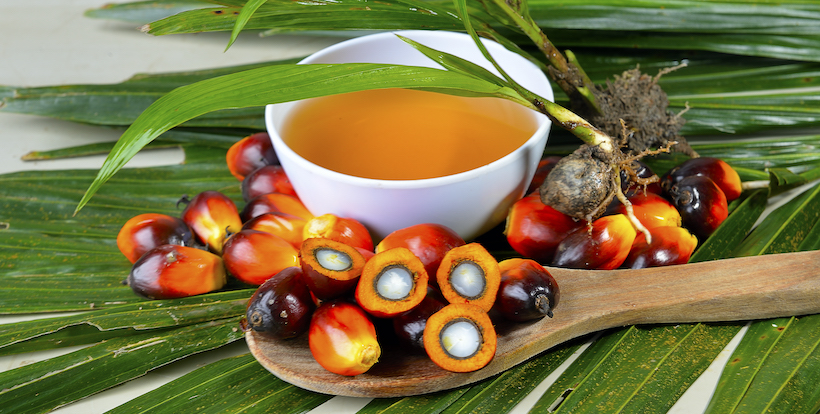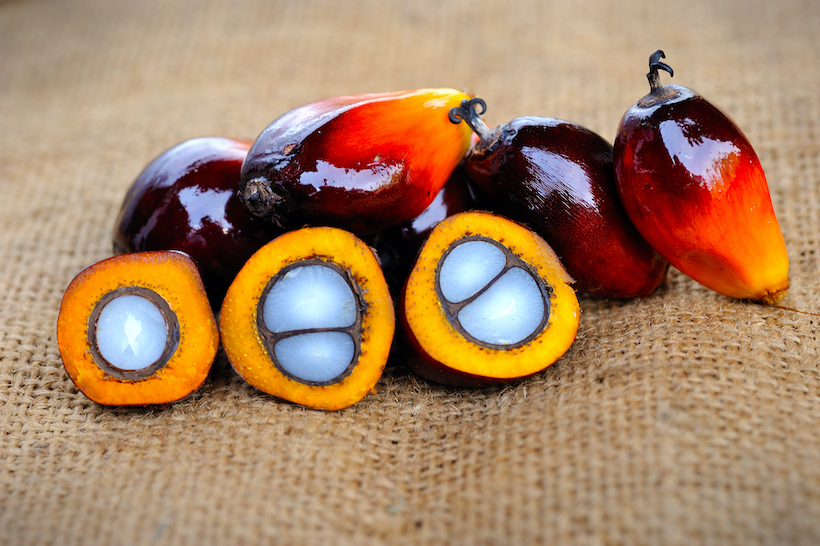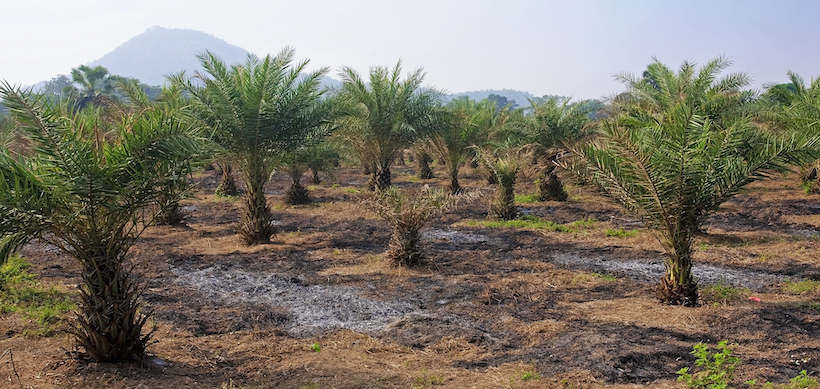Over the past decade, our family's diet has gone through significant changes. One place where we've changed quite a bit is around our intake of oils and fats. (C'mon, canola oil and – until recently – margarine?)
One such addition is palm oil, a substance that is quickly becoming an important part of our Western diet and has made its way into all kinds of food. Admittedly, I prefer its cousin coconut oil – but I know many people who swear by it for cooking and for cosmetic routines.
Let's settle this and look into the health effects of palm oil.

Palm oil is an oil derived from the pulp found in the oil palm tree. Most commonly, it's extracted from the oil palm trees Elaeis guineensis, endemic to west and southwest Africa. Around 85% of palm oil now comes from Elaeis guineensis trees in Malaysia and Indonesia.
For the remainder, some palm oil comes from varieties such as the Elaeis oleifera and Attalea maripa. (Those trees are most commonly found in South America and the Caribbean)
Because it yields a significant amount of oil with little treatment, the cultivation and exploitation of the oil palm tree have gained a lot of support in various regions of the world – including major countries in all major (populated) continents. However, palm oil's ascension hasn't been without its share of controversies...
Environmentalist groups have been increasingly pointing out that the cultivation of oil palms has brought harmful practices such as the clearing of native forests. Regions like Indonesia have suffered extensive environmental and societal damage due to the widespread demand for oil palm cultivation and its ensuing political tensions.
The oil palm tree originated in West Africa. The earliest we know palm oil was used is 3,000 B.C.E. – archaeologists found Elaeis Guineensis in a tomb in Abydos, Egypt.
There is early evidence of the substance used in burial and religious rituals (like with the aforementioned tomb-find). Western Europe was introduced to palm oil in the 1500s or 1600s, and colonial powers eventually cultivated and traded palm oil from ports such as Nigeria. (The British drove much of the early worldwide popularity).
Nowadays, palm oil is everywhere – and it's used in food preparation by a large variety of cultures all over the world.

Making palm oil is relatively simple – but this is where the first major differences come into play. The same plant – really, the same fruit – can create both palm oil and the closely related palm kernel oil.
First, the palms are collected, prepared, and milled. After milling comes refining, which uses fractionation, crystallization, and separation to divide solid and liquid byproducts. After removing impurities, the liquid (oily) fraction is filtered to make it edible and visually appealing.
The palm oil comes from the pulp or mesocarp of the palm fruit. The 'seed' or kernel inside also yields oil when crushed – oil form this method gets the designation palm kernel oil.
From the first refining process, you're first left with red palm oil. This version is commonly used as cooking oil. With extra refinement, red palm oil is converted into regular palm oil – stripped of much of its smell and taste and (unfortunately) many of its beneficial antioxidants and carotenoids.
Palm oil has a smoke point of 466 degrees Fahrenheit (230 degrees Celsius). As you probably know, that's quite a high smoke point compared to other cooking oils. This makes palm oil an excellent option for cooking at high temperatures.
(On the other hand, since it's high in saturated fat and solid – or semi-solid – at room temperature, palm oil is not great for cooking at low temperatures.)

Palm oil is, as you know, a fatty substance. One tablespoon of pure palm oil contains around 14 grams of fat. It breaks into 50% saturated fats (the vast majority palmitic acid), 40% monounsaturated (mostly oleic), and 10% polyunsaturated.
There are some definite advantages and benefits to the chemical composition of the edible substance. A great example is beta-carotene, one of the many antioxidants (and, as it turns out, colorings) known as carotenoids found in palm oil.
Beta-carotene, in particular, can help your body produce vitamin A, making its consumption extremely important. But it doesn't stop there – palm oil also contains alpha-carotene and lycopene, better known for its (red) appearance in ketchup.
Without a doubt, the type of oil that is most comparable to palm oil is coconut oil.
Indeed, both types of oil have plenty of similarities – along with the third member of the trifecta, palm kernel oil. Of course, the fact that all come from the same family of tree also tends to generate some level of confusion among people in general.
Here's the breakdown:
The fatty acid profile of coconut and palm oil is quite different. Coconut oil contains 92% saturated fatty acids, 6% monounsaturated fatty acids, and only 2% polyunsaturated fatty acids. As a result, coconut oil is almost always a solid at room temperature and has a slightly higher smoke point to boot.

Until recently, scientists were dubious that palm oil was a healthy fat. But now, evidence is accumulating suggesting that they were a bit naive.
Let it be said, though, that many of these studies have yet to provide definite results. While we wait for the evidence to shake out, join me in looking into seven of the potential health benefits of palm oil:
Several studies point out the effectiveness of the carotenes found in palm oil against cancer. In particular, the substance seems to be effective against breast cancer.
Beta-carotene found in palm oil has been proven to have amazing immune-modulatory effects, which can significantly slow down and perhaps even stop the multiplication of cancer cells.
Recent studies have shown that one member of the vitamin E family found in palm oil, α-tocotrienol, can help regulate specific mediators of cell death in the human brain.
It's possible a regular diet of palm oil and its derivates can reduce neurodegeneration – resulting in a brain better protected against acute ischemic stroke injury.
As mentioned above, tocotrienols are abundant in palm oil.
Beyond just stroke protection, these components have been found to provide a significant amount of protection for individual brain cells, resulting in a brain that is more well-equipped for handling and recovering from traumatic episodes of various kinds. Interestingly, tocotrienols seem to be able to prevent brain cells from dying during these episodes.

As you already know, red palm oil contains a variety of carotenes, including the mighty beta-carotene.
Beta carotene is a precursor, or provitamin, of vitamin A – it converts to vitamin A in your body. Patients that suffer from cystic fibrosis often have nutrition problems related to the malabsorption of lipid-soluble vitamins, including the aforementioned vitamin A.
Luckily, red palm oil has been proven to increase the absorption of not just vitamin A but other nutrients, too.
In addition to carotenes, palm oil contains various other antioxidants, many of which have benefits for the human body. Some of them have been shown to help the body fight negative symptoms associated with atherosclerosis.
Not only that: Over time, these antioxidants can also help slow down the progression of atherosclerosis in a definite, notable way. So far, studies seem to point (again) to tocotrienols being the main antioxidant agent in palm oil effective against disease progression.
Believe it or not, even though it's fat, there is evidence pointing to palm oil being effective in lowering blood triglycerides.
This, in turn, can help patients reduce their blood triglycerides – and, by consequence, keep arteries veins supple – fat in a natural, healthy manner.
One of the things that make red palm oil unique is its carotenes, tocopherols, and tocotrienols. (Which is why we keep talking about them!)
Among their health effects, you can see an increase of retinol levels in people with deficient vitamin intakes plus a reduction of atherosclerosis risks. However, one of the most interesting effects of red palm oil is its reduction of tumors.
Some studies (but not all) have shown that the tocopherols in red palm oil can help slow down the progressive growth of tumors.

Like all edible substances, palm oil has – or can have – adverse effects.
Of course, moderate consumption of the substance presents very few problems. However – although attitudes around saturated fat have been changing, I have to note that the AHA still recommends keeping it a minimum – 5% - 6% – of your daily fat intake.
Let's look at some of the adverse effects now.
After reading this subtitle, it may be confusing to find out that palm oil does not contain cholesterol in any way, shape, or form.
However, saturated fat consumption, in general, has been shown to increase cholesterol and triglyceride levels. This is theorized (although perhaps not proven) to increase the risks to your arterial walls.
Considering the theory – in combination with the fact that each tablespoon contains up to 7 grams of saturated fats – it's easy to understand how it might be a problem.
One study compared vegetable oils that are low in saturated fats to palm oil. Palm oil was shown to increase LDL cholesterol by 0.24 mmol/L relative to the other fats.
Signal? Noise? I know which way I'm betting, but this is an important one to consider before replacing all of your oil with something saturated.
Over the years, many concerns have been raised around the supposed negative effects that palm oil has on your heart. The main argument against palm oil regarding its cardiovascular effects is that it contains the saturated fatty acid palmitic acid in high proportions. In theory, (and as you saw above), this is why palm oil can elevate low-density lipoprotein cholesterol levels.
However, more recent studies throw doubt into the mix and argue that palm oil is, instead, healthy and protective for the heart.
Palm oil, with its 50% saturated fats, is pretty resistant to oxidation and rancidity even at room temperature. However, palm oil does oxidize – and oxidized oil does not have the same healthy effects as fresh palm oil.
Various studies have shown that oxidized palm oil seems to induce a negative lipid profile, which can increase cholesterol gain for than with unoxidized oil. Also, oxidized oil may have more toxic effects on the kidney, lung, liver, and heart.
While you can store palm oil at room temperature, it lasts better in the fridge – and either way, keep it out of the sun.

It's time, let's pose the question: Is palm oil good for you?
Generally speaking, I would say that it is – especially when taking in the red palm oil form, stored well, and not overly refined.
Considering its well-proven antioxidant effects as well as its abundance of beta-carotene, palm oil has many provable benefits to your health. What's more, palm oil seems to have neuroprotective, cancer-fighting, and antitumor effects.
However, when talking about the environment, the balance between positive and negative isn't as clear-cut.
Without a doubt, the cultivation of palm trees can have negative effects on a region's ecological system. In particular, the clearing of forests and other bio-diverse areas can be incredibly harmful to the environment.
It's undeniable that palm oil has many nutritional and even cultural benefits compared to other oils. In the end, a moderate, responsible, and informed palm oil consumption will always have the most favorable results for everyone involved – for our health and the planet's.
For thousands of years, we've been cultivating and using Elaeis guineensis, the oil palm. Although it temporarily went out of style due to dietary guidelines, it's a great substance and certainly holds up well to other cooking oils. Just be sure to find a responsible brand – some forms of cultivation are wholly unsustainable.
On the whole, I like palm oil, especially varieties without much refinement with that nice reddish/orange color. While I still prefer coconut oil to palm, palm oil is a great choice for your kitchen.